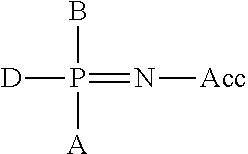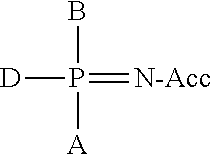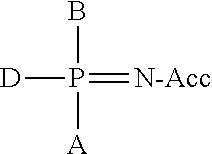Primers with Modified Phosphate and Base in Allele-Specific PCR
a technology of allele-specific amplification and primers, applied in the field of allele-specific amplification, can solve the problems of poor selectivity of allele-specific pcr, 7-cycle delay in amplification of mismatched templates, and insufficient degree of discrimination for many
- Summary
- Abstract
- Description
- Claims
- Application Information
AI Technical Summary
Benefits of technology
Problems solved by technology
Method used
Image
Examples
example 1
Primers for Detecting Mutation G719S in the Human EGFR Gene
[0076]The amplification reactions shown below were carried out using a detection probe (SEQ ID NO: 2) and forward primer (SEQ ID NO:1) common to both wild type and mutant targets. The reverse primer in each reaction is shown in Table 1 as: SEQ ID NO:3, a primer common to both mutant and wild type target; or SEQ ID NO:4, 5, 6, 7, 8, primers that are matched to the G719S mutant target sequence and mismatched to the wild type target at the 3′ terminal base position.
[0077]Targets used in these reactions are either pooled human WT genomic DNA (provided by Clontech) or a mutant plasmid construct containing a 500 bp G719S sequence insert into a pUC19 plasmid vector (provided by IDT as a minigene).
[0078]Mutant or wild type DNA was amplified in reactions that consisted of 50 mM Tris-HCl (pH 8.0), 80 mM potassium Chloride, 160 μM dATP, 160 μM dCTP, 160 μM dGTP, 320 μM dUTP, 0.1 μM each of selective and common primer, 0.05 μM probe, 20...
example 2
Primers for Detecting Mutation L858R in the Human EGFR Gene
[0081]The amplification reactions shown below were carried out using a detection probe (SEQ ID NO: 10) and forward primer (SEQ ID NO: 9) common to both wild type and mutant targets. The reverse primer in each reaction is: SEQ ID NO: 11, a primer common to both mutant and wild type target. or SEQ ID NO: 12, 13, 14, 15, 16, 17, primers that are matched to the L858R mutant target sequence and mismatched to the wild type target at the 3′ terminal base position.
[0082]Targets used in these reactions are either pooled human WT genomic DNA (provided by Clontech) or a mutant plasmid construct containing a 500 bp L858R sequence insert into a pUC19 plasmid vector (provided by IDT as a minigene).
[0083]Mutant or wild type DNA was amplified in reactions that consisted of 50 mM Tris-HCl (pH 8.0), 80 mM potassium Chloride, 160 μM dATP, 160 μM dCTP, 160 μM dGTP, 320 μM dUTP, 0.1 μM each of selective and common primer, 0.05 μM probe, 200 nM N...
example 3
Primers for Detecting Mutation T790M in the Human EGFR Gene
[0086]The amplification reactions shown below were carried out using a detection probe (SEQ ID NO:19) and forward primer (SEQ ID NO: 18) common to both wild type and mutant targets. The reverse primer in each reaction is: SEQ ID NO: 20, a primer common to both mutant and wild type target or SEQ ID NO: 21, 22, 23, 24, 25, primers that are matched to the T790M mutant target sequence and mismatched to the wild type target at the 3′ terminal base position.
[0087]Targets used in these reactions are either pooled human WT genomic DNA (provided by Clontech) or a mutant plasmid construct containing a 500 bp T790M sequence insert into a pUC19 plasmid vector (provided by IDT as a minigen).
[0088]Mutant or wild type DNA was amplified in reactions that consisted of 50 mM Tris-HCl (pH 8.0), 80 mM potassium Chloride, 160 μM dATP, 160 μM dCTP, 160 μM dGTP, 320 μM dUTP, 0.1 μM each of selective and common primer, 0.041M probe, 200 nM NTQ21-46...
PUM
| Property | Measurement | Unit |
|---|---|---|
| Selectivity | aaaaa | aaaaa |
Abstract
Description
Claims
Application Information
 Login to View More
Login to View More - R&D
- Intellectual Property
- Life Sciences
- Materials
- Tech Scout
- Unparalleled Data Quality
- Higher Quality Content
- 60% Fewer Hallucinations
Browse by: Latest US Patents, China's latest patents, Technical Efficacy Thesaurus, Application Domain, Technology Topic, Popular Technical Reports.
© 2025 PatSnap. All rights reserved.Legal|Privacy policy|Modern Slavery Act Transparency Statement|Sitemap|About US| Contact US: help@patsnap.com



